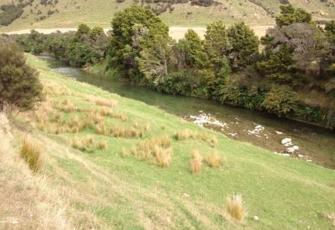This dashboard shows information on the data collected by the regional councils and unitary authorities for water quality indicators, analysed as state and trend. Select an indicator to see the historical monitoring data.
-
State
State shows how the median of samples from this site compares to other sites.
This site is a {{siteDescription}} site. Currently showing the state of this site compared to:
-
The state is also represented by attribute bands in the National Policy Statement for Freshwater Management 2020 for some indicators.
-
Trend
Trend shows how the quality of water is changing over time. Depending on the sampling history duration, five, ten, fifteen and twenty year timescales are available:
The state is also represented by attribute bands in the National Policy Statement for Freshwater Management 2020 for some indicators.
State
State
Trend
Sample history at this site
What is this graph showing me?
This graph is displaying E. coli concentrations over the selected time period. You can adjust this period by changing the dropdowns. These records form the basis for the state and trend indicators displayed on the dashboard. Find out about how State and Trend are calculated.
Monitoring data are displayed from 2004 onwards (where available). Data displaying from 2025 may not have gone through council quality assurance processes and should be treated as unverified.
What do the attribute band icons mean?
The bands for E. coli are as outlined in the National Policy Statement for Freshwater Management 2020
State
State
Trend
Sample history at this site
What is this graph showing me?
This graph is displaying Black Disc readings over the selected time period. You can adjust this period by changing the dropdowns. These records form the basis for the state and trend indicators displayed on the dashboard. At some sites Black Disc is not measured - here the calculation of the state attribute band for Clarity (suspended fine sediment) has used Clarity measurements converted from Turbidity data (where available). Find out about how State and Trend are calculated.
Monitoring data are displayed from 2004 onwards (where available). Data displaying from 2025 may not have gone through council quality assurance processes and should be treated as unverified.
What do the attribute band icons mean?
The bands for Clarity (suspended fine sediment) are as outlined in the National Policy Statement for Freshwater Management 2020
State
Trend
Sample history at this site
| NTU | FNU |
What is this graph showing me?
This graph is displaying Turbidity levels over the selected time period. You can adjust this period by changing the dropdowns.
Yellow coloured bars on the graph represent turbidity values measured in NTU. These records form the basis for the state and trend indicators displayed on the dashboard. Some councils now also measure turbidity in FNU. The FNU data (blue coloured bars) are not used by LAWA for the state and trend indicators. Find out about how State and Trend are calculated.
Monitoring data are displayed from 2004 onwards (where available). Data displaying from 2025 may not have gone through council quality assurance processes and should be treated as unverified.
State
Trend
Sample history at this site
What is this graph showing me?
This graph is displaying Total Nitrogen concentrations over the selected time period. You can adjust this period by changing the dropdowns. These records form the basis for the state and trend indicators displayed on the dashboard. Find out about how State and Trend are calculated.
Monitoring data are displayed from 2004 onwards (where available). Data displaying from 2025 may not have gone through council quality assurance processes and should be treated as unverified.
State
Trend
Sample history at this site
What is this graph showing me?
This graph is displaying Total Oxidised Nitrogen concentrations over the selected time period. You can adjust this period by changing the dropdowns. These records form the basis for the state and trend indicators displayed on the dashboard. Find out about how State and Trend are calculated.
Monitoring data are displayed from 2004 onwards (where available). Data displaying from 2025 may not have gone through council quality assurance processes and should be treated as unverified.
State
Trend
Sample history at this site
What is this graph showing me?
This graph is displaying Dissolved Inorganic Nitrogen concentrations over the selected time period. You can adjust this period by changing the dropdowns. These records form the basis for the state and trend indicators displayed on the dashboard. Find out about how State and Trend are calculated.
Monitoring data are displayed from 2004 onwards (where available). Data displaying from 2025 may not have gone through council quality assurance processes and should be treated as unverified.
State
State
Trend
Sample history at this site
What is this graph showing me?
This graph is displaying Ammoniacal Nitrogen concentrations over the selected time period. These monitoring data have not been pH adjusted. You can adjust this period by changing the dropdowns. These records form the basis for the state and trend indicators displayed on the dashboard. Find out about how State and Trend are calculated.
Monitoring data are displayed from 2004 onwards (where available). Data displaying from 2025 may not have gone through council quality assurance processes and should be treated as unverified.
What do the attribute band icons mean?
The bands for Ammonia (toxicity) are as outlined in the National Policy Statement for Freshwater Management 2020
State
State
Trend
Sample history at this site
What is this graph showing me?
This graph is displaying Nitrate Nitrogen concentrations over the selected time period. You can adjust this period by changing the dropdowns. These records form the basis for the state and trend indicators displayed on the dashboard.* Find out about how State and Trend are calculated.
*For sites where there are not enough Nitrate Nitrogen data available, Total Oxidised Nitrogen (TON) data have been used instead to calculate state and trend.
Monitoring data are displayed from 2004 onwards (where available). Data displaying from 2025 may not have gone through council quality assurance processes and should be treated as unverified.
What do the attribute band icons mean?
The bands for Nitrate (toxicity) are as outlined in the National Policy Statement for Freshwater Management 2020
State
State
Trend
Sample history at this site
What is this graph showing me?
This graph is displaying Dissolved Reactive Phosphorus concentrations over the selected time period. You can adjust this period by changing the dropdowns. These records form the basis for the state and trend indicators displayed on the dashboard. Find out about how State and Trend are calculated.
Monitoring data are displayed from 2004 onwards (where available). Data displaying from 2025 may not have gone through council quality assurance processes and should be treated as unverified.
What do the attribute band icons mean?
The bands for Dissolved Reactive Phosphorus are as outlined in the National Policy Statement for Freshwater Management 2020
State
Trend
Sample history at this site
What is this graph showing me?
This graph is displaying Total Phosphorus concentrations over the selected time period. You can adjust this period by changing the dropdowns. These records form the basis for the state and trend indicators displayed on the dashboard. Find out about how State and Trend are calculated.
Monitoring data are displayed from 2004 onwards (where available). Data displaying from 2025 may not have gone through council quality assurance processes and should be treated as unverified.

